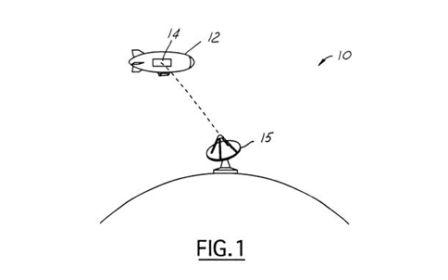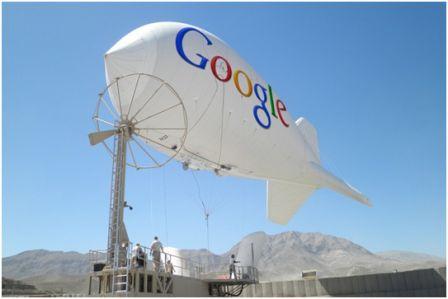It seems that when it comes to Sci-Fi movies that show an alternate Earth, the sky is always filled with blimps used by law enforcement agencies or government monitoring systems. It never ceases to amaze me how something we see in a movie eventually comes into existence.
In 2000, Google filed for a patent called the “High Altitude Platform System.” Any guesses what that might be? How about a ground station sending a signal to a high flying blimp? According to the patent filing (publication number US6513758 B1, filing date August 21, 2000), the description is as follows:
The present invention relates generally to a movable platform or appendage as on an air or space vehicle, and more particularly to a movable platform or appendage that needs to be accurately controlled.

If you want to read all of the details and see additional drawings as to the concept and how this would actually work, you can go to Google’s patent area and check out the details.
According to WIRED, Google may be taking this concept out of bottom drawer and is intending to build huge wireless networks across Africa and Asia. Google will do this using high altitude balloons and blimps as a way of bringing the Internet to areas that currently have no infrastructure for high speed wireless.

Having a new, I guess that you can call the blimps an infrastructure, in place wouldn’t have much meaning if there was nothing to take advantage of it. Towards that end, Google has been putting together an ecosystem of low cost smartphones. These are Android devices that run on low power microprocessors.
The blimps and balloons that will comprise the high altitude platforms will be able to transmit to areas that are hundreds of square kilometers. According to a post from the Wall Street Journal, Google may also be considering the use of satellites. An un-named Google spokesperson said, “There’s not going to be one technology that will be the silver bullet.”
Google’s plan is to use the spectrum known as TV white space. These are vacant frequencies made available for use at locations where spectrum is not being used by licensed services such as TV broadcasting. The spectrum is located in the VHF 54-216 MHz and 470-698 MHz in the UHF bands. This spectrum is very suitable for wireless communications.
Google lobbyists are also trying to gain access to airwaves that are currently reserved for TV broadcasts. They operate at lower frequencies, are capable of penetrating buildings and can also travel longer distances than the current Wi-Fi technology.
As of now, Google has some small scale versions of this type of network in Cape Town, Africa. In March the company announced their plan to make use of this television white space and deliver Internet access to African schools and universities as well as deep rural areas.
The combination of introducing an ecosystem of low cost smartphones and being able to reach areas from sub-Saharan Africa to Southeast Asia that have no infrastructure shows that Google might be very serious about developing this concept.
It will certainly be interesting to see what the skies look like with blimps flying over the Sahara Desert.
Edited by
Lacey Henry
 QUICK LINKS
QUICK LINKS